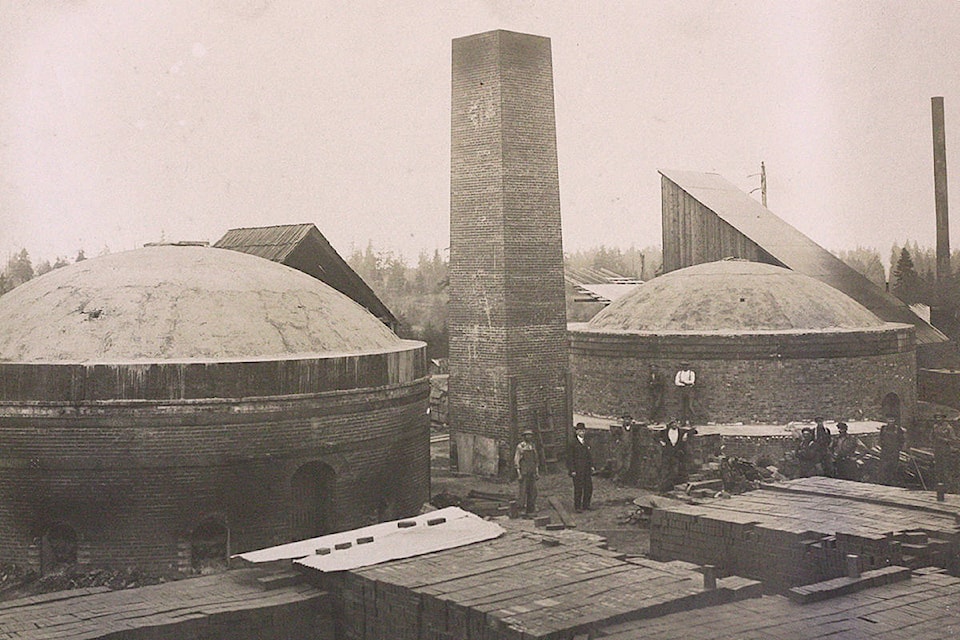Nanaimo made a contribution to the bricks-and-mortar foundations of British Columbia.
It wasn’t only coal that was dug from the earth in the mid-Island – shale was another commercial resource, and at least six brickyards operated in the region in the early part of the 20th century.
As early as the 1850s, the Hudson’s Bay Company had identified Nanaimo as a good location for brick-making, noted John D. Adams in a 1987 essay in B.C. Studies.
“Geologically the choice was obvious, because good quality clay … is frequently found adjacent to coal beds,” he wrote. “The Nanaimo clays did give rise later in the 19th century to several commercial brickyards.”
Nanaimo’s bricks have endured, a little worse for wear. Bits of red brick are scattered along Brickyard Beach on Gabriola Island where the Dominion Shale, Brick and Sewer Pipe Company, and later, Gabriola Shale Products, operated for decades. Brickyard Community Park in Nanoose Bay’s Fairwinds neighbourhood and Brickyard Road in Nanaimo were also located near former sites of smaller brick-making operations.
When Harewood School, built in 1914, was demolished in 2011, some of the rubble was bricks that had been fired at the Nanaimo Pressed Brick and Terra Cotta Company on Maxey Road. Former city alderman Henry Shepherd managed that brickyard and his grandson, Chester Shepherd, said the Nanaimo bricks were used on both sides of the Strait of Georgia.
“God only knows where the bricks went,” Chester said. “All those bricks in Nanaimo are bought probably from my grandfather. I don’t know, I’m just guessing that’s true. They must have been.”
The Nanaimo brickyard wasn’t a long-lasting enterprise; “it closed down in the First World War because nobody was building anything,” Chester said.
The Mountain District Brick and Tile Company in East Wellington similarly stopped and started operations during the same era and the East Wellington Pressed Brick and Tile Company was a still shorter-lived operation.
Brick making had comparatively more significance to Gabriola’s history. Dominion had the most modern equipment available, including five kilns, and its two presses could turn out 4,000 bricks per hour, according to Henry Boam’s 1912 book British Columbia: Its History, People, Commerce, Industries and Resources. The brickyard’s proximity to deep water was an advantage, as the bricks were loaded onto a scow and tugged over to Vancouver.
Jenni Gehlbach, in an essay in Gabriola Historical and Museum Society’s Shale magazine, noted that Gabriola Shale Products reported that it manufactured 3.5 million bricks in 1920. The company “appears to have operated smoothly” the rest of that decade, she wrote, before slowdowns and shutdowns during the 1930s. The site was abandoned in the 1950s and ’60s, designated Crown land in 1974 and eventually bulldozed.
“The rest of the site on the hillside has returned to leafy peace,” Gehlbach wrote.
It’s interesting, said Christine Meutzner, manager of the Nanaimo Community Archives, that despite the brick making in the region, bricks were a comparatively rare building material locally.
But whether here or across the strait, Nanaimo’s brickyards did help build B.C., brick by brick.
greg.sakaki@nanaimobulletin.com
This brick was taken from the rubble of Harewood School. Read about Nanaimo's brick-making history here… https://t.co/s4oF8ZoMqY #history pic.twitter.com/MaQ05JsfCa
— Nanaimo Bulletin (@NanaimoBulletin) May 17, 2017
